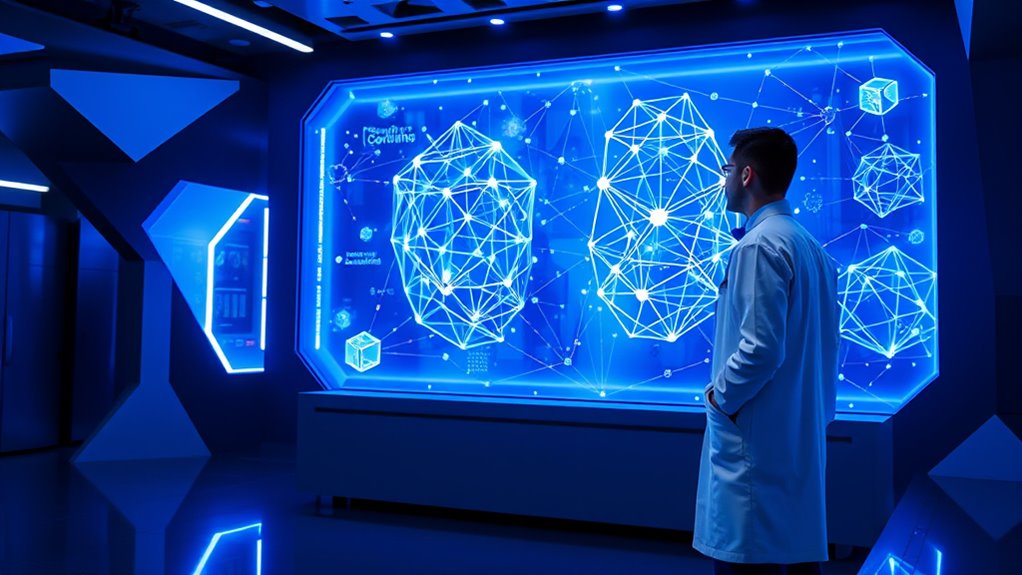Geometric deep learning is transforming AI by enabling models to better understand complex, irregular data like graphs and manifolds. This approach preserves the structure and relationships within non-Euclidean data, leading to improvements in social network analysis, healthcare, and drug discovery. By capturing topological features and symmetry, these models can make more accurate predictions and decisions. If you’re curious about how this innovation is shaping the future, there’s much more to uncover.
Key Takeaways
- Geometric deep learning enables AI to effectively analyze complex, irregular data like graphs and manifolds, enhancing insights across fields.
- It improves personalization and decision-making by capturing intrinsic data structures and relationships.
- Advances in this area accelerate real-time processing, making AI systems more responsive and scalable.
- Applying geometric principles ensures AI models respect data symmetry and topology, increasing accuracy and robustness.
- This technology promises transformative impacts in healthcare, social networks, and beyond by handling complex, high-dimensional data.
Understanding the Foundations of Geometric Deep Learning
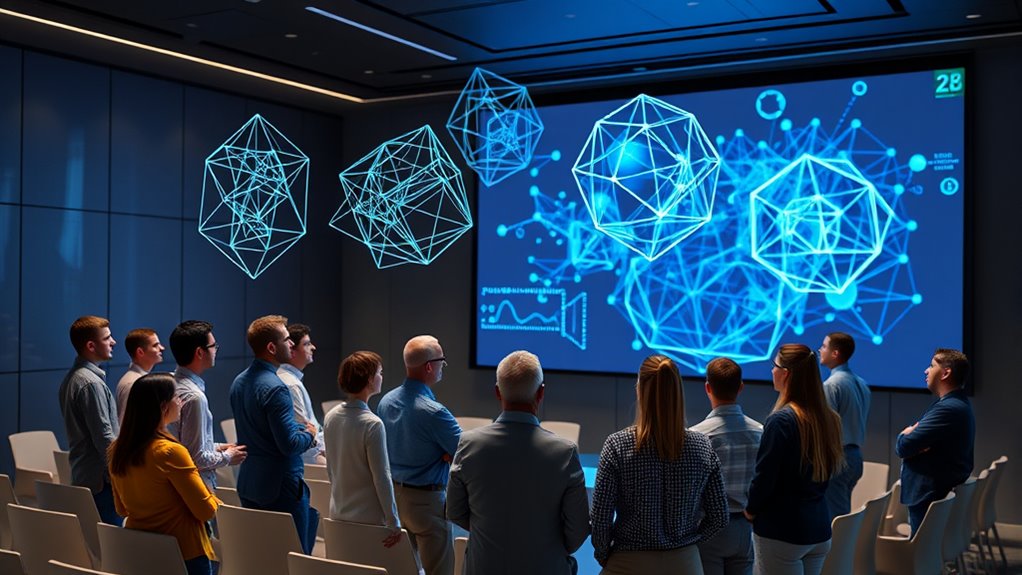
To understand geometric deep learning, grasping how it extends traditional neural networks to non-Euclidean data structures like graphs and manifolds is essential. You focus on graph structures, which consist of nodes and edges representing complex relationships. Unlike regular grids, these structures have irregular connections and varying topologies. Topological features—such as connectivity patterns and node relationships—are critical because they capture the intrinsic shape and structure of data. By leveraging these features, geometric deep learning models can analyze data more effectively, preserving spatial relationships and structural information. This approach allows neural networks to process complex, non-linear data types that traditional models struggle with, opening new avenues for AI applications across diverse fields. Additionally, understanding the Topological features helps in designing more robust and adaptable models capable of handling real-world, irregular data.
Key Differences Between Traditional and Geometric Approaches
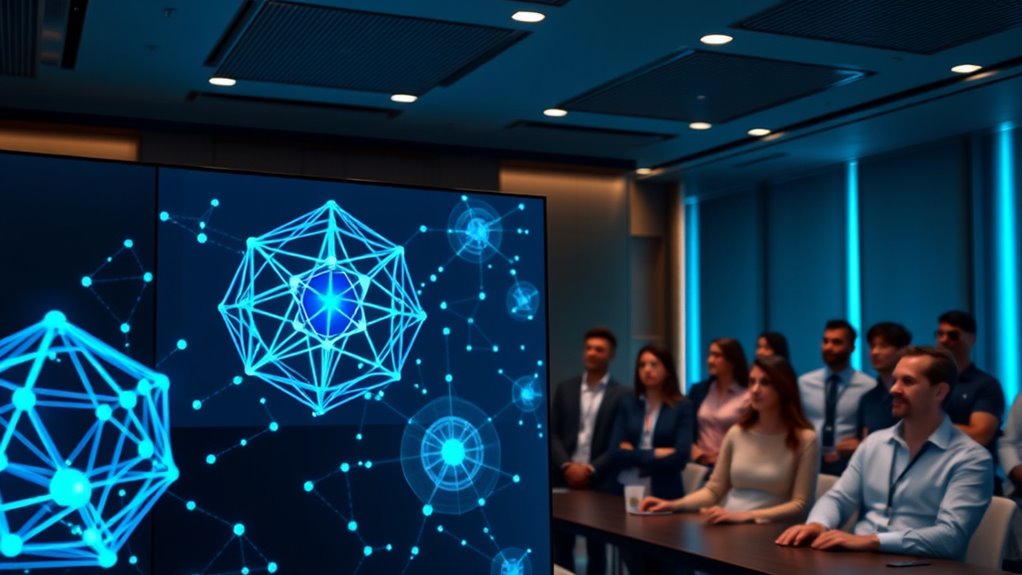
Traditional neural networks excel at processing data with regular structures, such as images and sequences, where the data points have fixed positions and consistent relationships. In contrast, geometric approaches focus on graph structures, which are inherently irregular and complex. These methods account for symmetry considerations, ensuring that the network’s output remains consistent regardless of how the data is rotated or reflected. Unlike traditional models that rely on fixed grid layouts, geometric deep learning adapts to the underlying data topology, capturing relationships that aren’t fixed or uniform. This flexibility allows it to analyze non-Euclidean data effectively, such as social networks or molecular graphs. The key difference lies in how each approach handles structure and symmetry, with geometric methods explicitly designed to respect the data’s intrinsic geometry.
Potential Applications in Social Network Analysis and Beyond
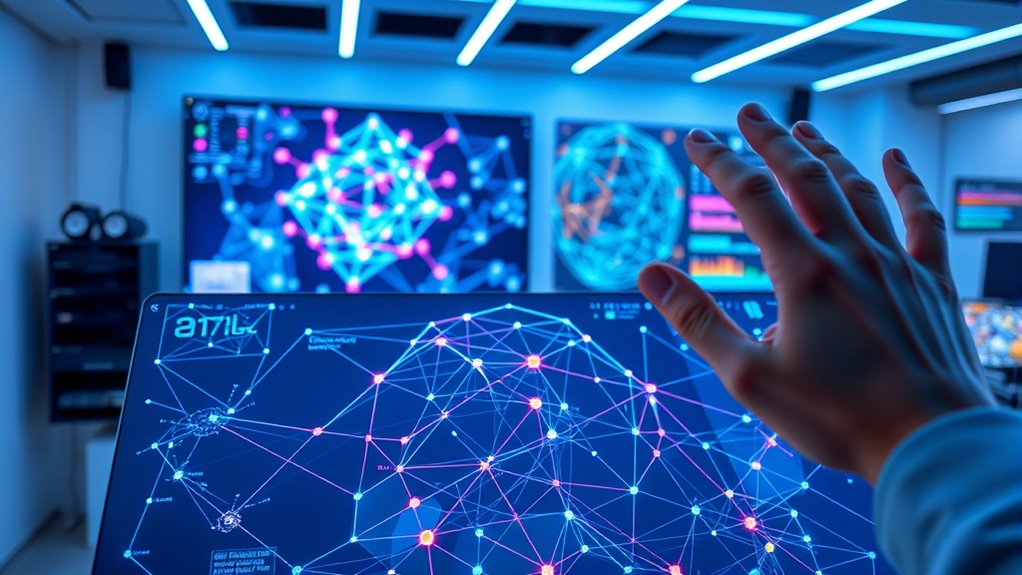
Geometric deep learning opens new possibilities for social network analysis by effectively modeling complex relationships and structures that traditional methods struggle to capture. Using techniques like graph convolution, you can analyze connections, influence patterns, and community dynamics with greater accuracy. Topological learning further enhances this by focusing on the network’s shape and structure, revealing hidden insights into user interactions and information flow. These approaches allow you to detect influential nodes, predict behaviors, and identify emerging trends more efficiently. Beyond social networks, geometric deep learning applies to recommendation systems, fraud detection, and knowledge graph analysis. By leveraging the spatial and relational context within data, you gain a deeper understanding of interconnected systems, enabling smarter decision-making across various domains. Incorporating principles from meditation can also promote mental clarity and focus during data analysis, leading to more insightful interpretations.
Advances in Drug Discovery and Healthcare Solutions
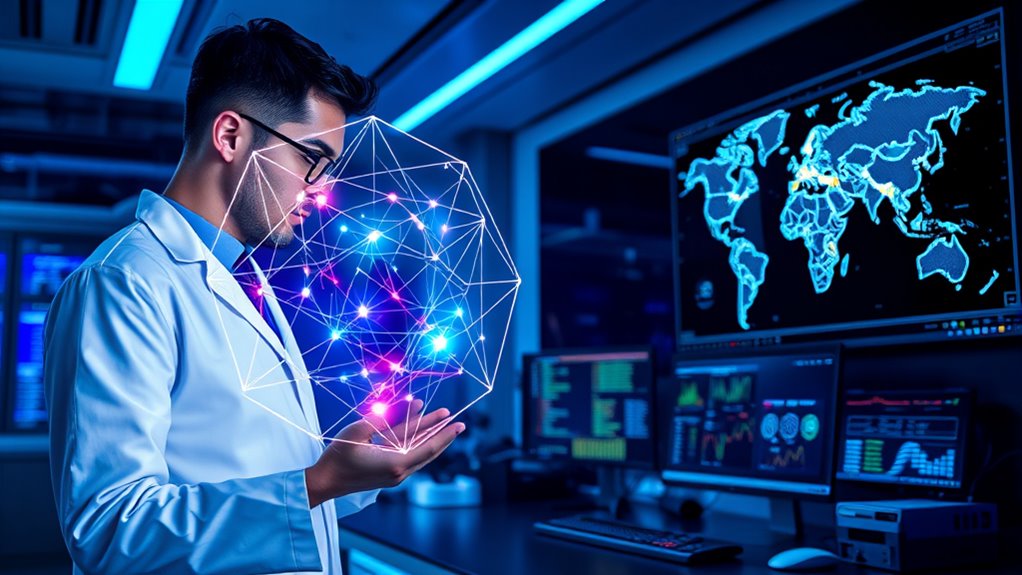
How are cutting-edge AI techniques transforming drug discovery and healthcare solutions? Geometric deep learning enables more accurate molecular modeling, speeding up the identification of promising drug candidates. It enhances personalized medicine by analyzing complex biological data to tailor treatments precisely. Here’s how it’s making an impact:
Cutting-edge AI accelerates drug discovery and personalizes treatments through advanced molecular modeling and biological data analysis.
- Accelerating drug development timelines through predictive modeling.
- Improving molecular understanding, leading to better-targeted therapies.
- Customizing treatments based on individual genetic and biological data.
- Reducing costs by streamlining research and clinical testing.
- Incorporating essential oils and natural compounds into innovative therapeutic approaches to complement conventional treatments.
These advances help you develop safer, more effective drugs faster, and deliver personalized healthcare solutions that fit each patient’s unique profile. Geometric AI’s ability to interpret complex biological structures is revolutionizing how medicine is designed, tested, and administered.
Challenges and Future Directions in Geometric AI

You’ll face significant hurdles with data complexity, which can make modeling intricate geometric structures difficult. Scalability and efficiency also pose challenges as models grow larger and more detailed, demanding more computational resources. Addressing these issues is vital for advancing Geometric AI and enabling its full potential.
Data Complexity Challenges
As the field of Geometric AI advances, researchers face increasing challenges related to data complexity, which can hinder model performance and scalability. Graph structures often contain intricate connections and varying node degrees, making it difficult to extract meaningful patterns. Data heterogeneity adds another layer of difficulty, as diverse data sources can differ significantly in format and quality. To navigate these challenges, you need to consider:
- Managing complex graph topologies with varying node and edge types
- Handling inconsistent data quality across heterogeneous sources
- Developing adaptable models that generalize well across diverse graph structures
- Ensuring robustness against noisy or incomplete data within complex datasets
- Improving color accuracy techniques to better interpret diverse visual data in complex graph representations
Addressing these issues is essential for enabling the full potential of Geometric AI in real-world applications.
Scalability and Efficiency
Addressing data complexity in Geometric AI often reveals deeper challenges related to scalability and efficiency. As graph structures grow larger, processing them demands significant computational power, slowing down algorithms and limiting real-world applications. Improving computational efficiency is vital for handling complex, large-scale data. You need methods that optimize graph processing without sacrificing accuracy, especially in real-time tasks. Future directions include designing more scalable algorithms and hardware solutions tailored to geometric data. The goal is to enable AI systems to manage extensive graph structures seamlessly. Here’s a quick overview:
| Challenge | Solution |
|---|---|
| Growing graph sizes | More efficient algorithms |
| High computational demands | Specialized hardware |
| Maintaining accuracy at scale | Approximation techniques |
Implications for the Future of Machine Learning and Human-Computer Interaction
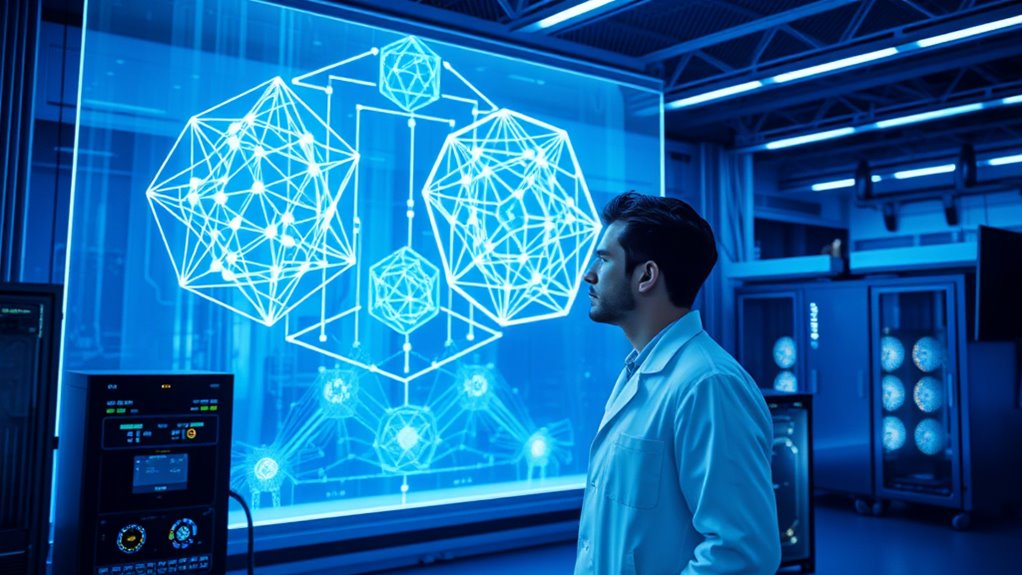
Geometric deep learning is poised to revolutionize how machines understand and interact with complex data structures, which, in turn, will profoundly influence the future of human-computer interaction. You’ll see smarter, more intuitive interfaces that adapt to your needs seamlessly. Here are four key implications:
Geometric deep learning will transform human-computer interaction with smarter, more intuitive, and adaptive interfaces.
- Quantum computing integration will accelerate processing, enabling real-time, complex data analysis.
- Enhanced personalization becomes possible, as machines better grasp your preferences through geometric patterns.
- Ethical considerations emerge around data privacy and decision transparency, requiring careful oversight.
- Human-AI collaboration will deepen, with more natural interactions that understand context and subtle cues.
Additionally, advancements in second trimester overview will inform the development of more responsive and adaptive AI systems in healthcare and other fields. This evolution will shape how you work, communicate, and make decisions, pushing machine learning toward more ethical and sophisticated horizons.
Frequently Asked Questions
How Does Geometric Deep Learning Handle Complex, Real-World Data Variability?
You might wonder how geometric deep learning manages complex, real-world data variability. It excels by leveraging sensor fusion, combining data from multiple sources to create an all-encompassing view. Additionally, it uses multi-scale analysis to capture both fine details and broader patterns across different levels. This approach helps you handle unpredictable data variations effectively, ensuring more accurate insights and robust performance in real-world applications.
What Are the Ethical Considerations With Advanced Geometric AI Systems?
When considering advanced geometric AI systems, you should be aware of ethical concerns like privacy worries and bias mitigation. You need to guarantee data is protected and that algorithms don’t perpetuate existing biases. By addressing these issues proactively, you help foster responsible AI development. It’s your responsibility to promote transparency and fairness, so these powerful systems serve everyone equitably without infringing on individual rights.
Can Geometric Deep Learning Improve Interpretability of AI Models?
You might wonder if geometric deep learning can make AI models more interpretable. It does this by using advanced visualization techniques to clarify complex data structures and relationships. Additionally, interpretability metrics help you evaluate how well the model’s decisions align with human understanding. By leveraging these tools, you gain clearer insights into your AI’s processes, making it easier to trust and refine the system effectively.
How Accessible Are Geometric Deep Learning Tools for Small Organizations?
Like climbing a steep mountain, accessing geometric deep learning tools can seem formidable for small organizations. Scalability challenges and complex algorithms pose hurdles, but open source initiatives act as guiding lights, making tools more accessible. These initiatives lower entry barriers, allowing you to experiment and innovate without hefty costs. With persistence and community support, small teams can harness geometric deep learning’s power, transforming their AI capabilities and leveling the playing field.
What Are the Risks of Overfitting in Geometric Neural Networks?
You’re right to worry about overfitting in geometric neural networks. If your model becomes too complex, it may fit the training data too closely, reducing its ability to generalize. To prevent this, you should use model regularization techniques and data augmentation strategies. These approaches help your network learn meaningful patterns without memorizing noise, ensuring better performance on unseen data.
Conclusion
Imagine a world where AI seamlessly navigates the complex web of social connections, molecules, and spaces around us. Geometric deep learning is opening that door, transforming how machines understand our universe’s shapes and structures. As you witness these breakthroughs, picture a future where healthcare, social insights, and human-computer interactions become more intuitive and powerful. This exciting journey is just beginning, promising a smarter, more connected world that you’ll help shape.
